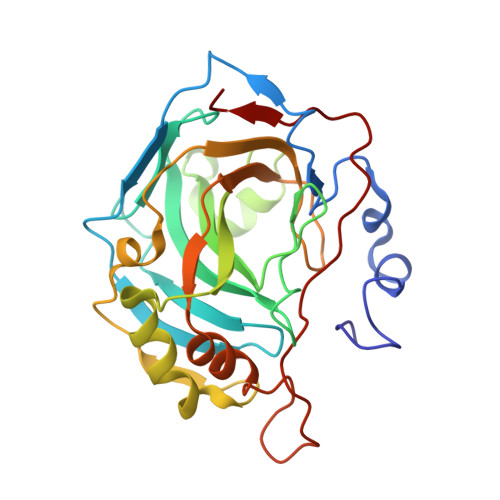Discovery of beta-Adrenergic Receptors Blocker-Carbonic Anhydrase Inhibitor Hybrids for Multitargeted Antiglaucoma Therapy.
Nocentini, A., Ceruso, M., Bua, S., Lomelino, C.L., Andring, J.T., McKenna, R., Lanzi, C., Sgambellone, S., Pecori, R., Matucci, R., Filippi, L., Gratteri, P., Carta, F., Masini, E., Selleri, S., Supuran, C.T.(2018) J Med Chem 61: 5380-5394
- PubMed: 29851481
- DOI: https://doi.org/10.1021/acs.jmedchem.8b00625
- Primary Citation of Related Structures:
5WLT, 5WLV - PubMed Abstract:
The combination of a β-adrenergic receptors (AR) blocker and a carbonic anhydrase (CA, EC 4.2.1.1) inhibitor in eye drops formulations is one of the most clinically used treatment for glaucoma. A novel approach consisting of single-molecule, multitargeted compounds for the treatment of glaucoma is proposed here by designing compounds which concomitantly interact with the β-adrenergic and CA targets. Most derivatives of the two series of benzenesulfonamides incorporating 2-hydroxypropylamine moieties reported here exhibited striking efficacy against the target hCA II and XII, whereas a subset of compounds also showed significant modulation of β 1 - and β 2 -ARs. X-ray crystallography studies provided rationale for the observed hCA inhibition. The best dual-agents decreased IOP more effectively than clinically used dorzolamide, timolol, and the combination of them in an animal model of glaucoma. The reported evidence supports the proof-of-concept of β-ARs blocker-CAI hybrids for antiglaucoma therapy with an innovative mechanism of action.
Organizational Affiliation:
Department of NEUROFARBA, Section of Pharmaceutical and Nutraceutical Sciences , University of Florence, Polo Scientifico , Via U. Schiff 6 , 50019 Sesto Fiorentino , Firenze Italy.






















